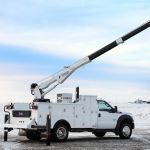We often discuss the benefits of having GPS tracking solutions or maintenance and uptime solutions, but are there downsides to employing the latest solutions that need to be taken into account? By implementing multiple solutions, are we losing important human interactions or reducing job availability? James Heim, author and technology consultant, discusses some of the potential downsides to employing technological fleet solutions. Telematics and other tech solutions are undoubtedly beneficial, but where do we draw the line?
MWS: IS THERE ANY REASON A COMPANY SHOULD HOLD OFF ON UPDATING TO THE “LATEST-AND-GREATEST” TECHNOLOGIES?
HEIM: The reasons a company considers updating to the “latest-and-greatest” technologies could be gains in efficiency, time savings, lower operational risks, and gains in worker safety. Of course, that’s legitimate. But, what are the consequences that come with that new technology apart from those aforementioned gains? Will workers be laid off? Will there be less human interaction, less human oversight, and less operational knowledge? Will company culture suffer or the idiosyncratic culture amongst employees, whether manager, tech, or driver?
Refraining from using new technologies in order to protect human essence or cultural aspects may seem unrealistic in a highly competitive environment, but there are always trade-offs. The company may gain efficiency and an improved bottom line, but these gains are “paid for” by the cultural—or human essence—costs that come with technology further displacing human involvement in whatever tasks and processes.
Consider this: A company refraining from applying some new technology for the above reasons seemingly forges organizational and financial advantages. However, just as there is a market for environmentally and socially conscious products and services, so too can there be a market for products and services that consider human essence aspects (similar to “Manufactured in the US”). These markets need to be created—not an easy task—but if successful, that first company may indeed get the advantage.
MWS: WHERE DO WE DRAW THE LINE BETWEEN MAXIMIZING SAFETY AND ELIMINATING THE HUMAN ELEMENT THROUGH WHAT ARE BECOMING AUTONOMOUS VEHICLES?
HEIM: I cannot specifically say where the line needs to be drawn and what particular technologies represent that line, because where the line exactly should be drawn is dependent on individual views and circumstances.
However, as explained above, we need to be mindful of the degree to which we replace human involvement with technology. Yes, there is a price to be paid for maintaining our connections/interactions with the real world. These connections and interactions may come with challenges and threats to our safety. But, these connections and interactions also give us a vital sense of relevance and involvement.
Letting technology completely takeover also comes with a price tag, which is represented by the consequences that come from being buffered/disconnected from real world issues and circumstances. For instance, failure of the technology we rely on for day to day production, deliveries, customer service, etc. can decrease uptime and revenue; ignorance of our technological circumstances, as very few experts understand the technological realities we have become so dependent on, which only increases a sense of personal/human irrelevance; ignorance of business and management practices we are no longer connected to, and are therefore no longer knowledgeable about.
MWS: HOW ARE OUR BASIC HUMAN RESOURCES BEING COMPROMISED BY THE USE AND INVENTION OF NEW TECHNOLOGIES?
HEIM: The time, problem-solving, cooperation, and creativity we use to invent and put into use a new technological system that helps streamline delivery or service is time, problem-solving, cooperation, and creativity we didn’t use to improve the overall business system by focusing on human interactions, work ethic, and satisfaction, or diligence. The technological improvement may be the more powerful improvement compared to the human-centric one, but this leads back to the trade-off issues described above.
Take GPS-enabled operations as an example: The advantages are clear, that’s why these GPS-enabled systems are becoming more pervasive and more deeply embedded in a company’s operations. One advantage includes not needing to consult a physical map, and therefore also not needing to know how to read maps. This leads to a decreased need to consult the dispatcher or get out of the truck and ask someone in the vicinity for directions, which decreases the need to have a sense of direction or familiarity with city or neighborhoods.
Technological progress makes aspects of in-person interactions less efficient compared to the newest technological solution.
ABOUT JAMES HEIM:
James Heim graduated from the University of Zurich and has worked with a Swiss foundation to bring technology companies to Switzerland. His work in this field, along with his close connection to nature, informed the research for his book Voluntary Enslavement: Technology’s Fast Development Reduces Diversity and Freedom. Find out more about Heim and his book, visit www.voluntaryenslavement.com.
_______________________________________________________________________
MODERN WORKTRUCK SOLUTIONS: FEBRUARY 2017 ISSUE
Did you enjoy this article?
Subscribe to the FREE Digital Edition of Modern WorkTruck Solutions magazine.
![]()




